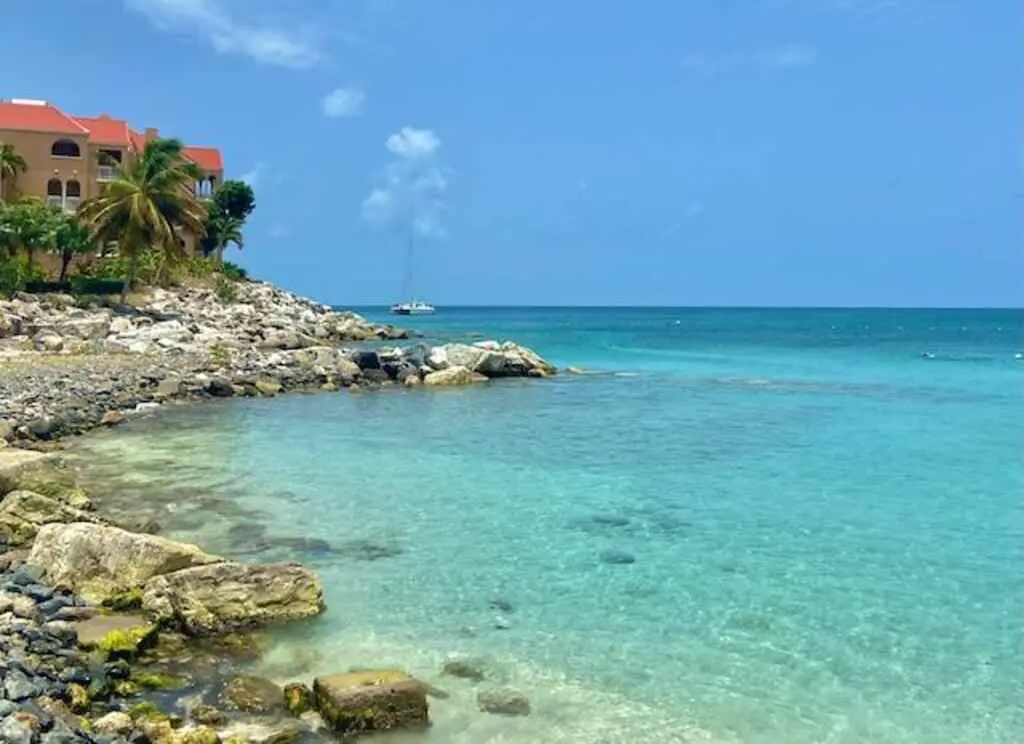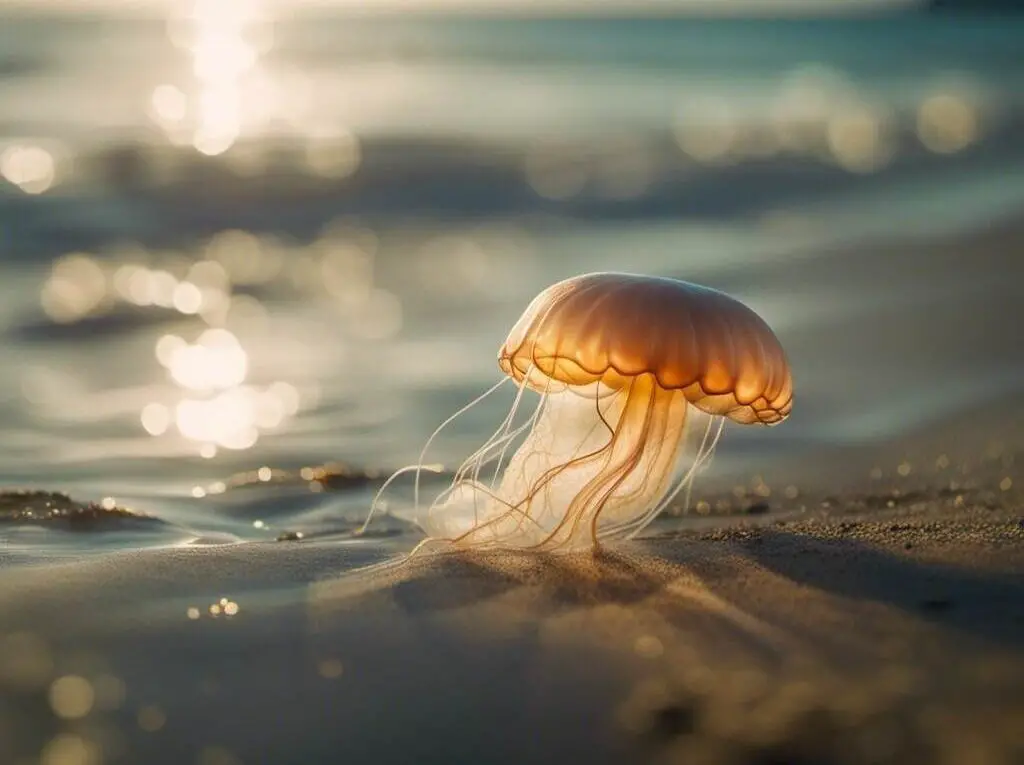Does Sint Maarten Have Jellyfish? Find Out The Truth Now!
If you are planning a trip to Sint Maarten, you may be wondering if jellyfish are present in the surrounding waters. The answer is yes, jellyfish can be found in Sint Maarten, but it is important to note that not all jellyfish are dangerous.
This article will provide you with all the information you need to know about the jellyfish in Sint Maarten, including the different species that can be found, their population and sightings, safety tips, and much more.
Table of Contents
- 1 Key Takeaways
- 2 Does Sint Maarten Have Jellyfish?
- 3 The Jellyfish Species Found in Sint Maarten
- 4 Jellyfish Population and Sightings in Sint Maarten
- 5 Jellyfish Safety Tips for Visitors to Sint Maarten
- 6 Best Beaches for Jellyfish Spotting in Sint Maarten
- 7 The Jellyfish Season in Sint Maarten
- 8 Symptoms and Treatment of Jellyfish Stings
- 9 Jellyfish Safety Tips for Visitors to Sint Maarten
- 10 The Impact of Jellyfish on Sint Maarten’s Ecosystem
- 11 Jellyfish Research and Conservation Efforts in Sint Maarten
- 12 Local Legends and Myths Surrounding Jellyfish in Sint Maarten
- 13 Conclusion
- 14 Frequently Asked Questions About Jellyfish in Sint Maarten
- 15 Author
Key Takeaways
- Sint Maarten’s waters can have jellyfish.
- Encounters with jellyfish are infrequent but possible.
- Visitors should stay cautious and vigilant when swimming.
- Check for any posted advisories regarding jellyfish presence.

Does Sint Maarten Have Jellyfish?
Yes, jellyfish can be found in the waters around Sint Maarten. While encounters are infrequent, it’s essential for beachgoers and swimmers to stay cautious and be aware of their surroundings. Jellyfish stings can be painful and cause mild to severe reactions.
It’s recommended to pay attention to any posted advisories and consult with local authorities or lifeguards for safety guidelines. If stung, rinse the affected area with vinegar or saltwater, and seek medical attention if needed.
By taking necessary precautions, visitors can still enjoy the beautiful beaches of Sint Maarten while minimizing the potential risks associated with jellyfish encounters.
The Jellyfish Species Found in Sint Maarten
Sint Maarten is home to a diverse array of jellyfish species that inhabit the waters surrounding the island. These include both native and non-native species that have been introduced to the area.
| Jellyfish Species | Description |
|---|---|
| Box jellyfish | One of the most dangerous jellyfish in the world with a potent venom that can be lethal to humans. |
| Portuguese man o’ war | A colonial organism made up of a group of specialized polyps that work together as a single entity. Its long, trailing tentacles can deliver a painful sting. |
| Moon jellyfish | A common jellyfish with a translucent bell and four horseshoe-shaped gonads visible through the top of its bell. Its sting is relatively mild and usually harmless to humans. |
| Upside-down jellyfish | A unique species that rests on the seafloor upside-down. Its tentacles extend upward to capture plankton and small fish. Its sting is not harmful to humans. |
In addition to these species, other jellyfish that have been sighted in Sint Maarten include the lion’s mane jellyfish and the sea nettle jellyfish. It is important to note that jellyfish populations can vary from year to year and may not be present at all times.

Jellyfish Population and Sightings in Sint Maarten
Sint Maarten is home to a variety of jellyfish species that can be found in its waters throughout the year. Among the most commonly sighted are the Portuguese Man o’ War, the Atlantic sea nettle, and the moon jellyfish.
The jellyfish population in Sint Maarten is affected by various environmental factors, such as water temperature, currents, and availability of food sources. There have been occasional outbreaks of jellyfish blooms in the area, which can lead to a higher concentration of individuals in some locations.
Jellyfish Sightings
There have been reports of jellyfish sightings in various areas of Sint Maarten, including popular beaches and bays. It is important to note that jellyfish movements and concentrations can vary greatly and change rapidly due to currents and wind direction.
Jellyfish sightings tend to be more common during the warmer months of the year, especially from June to September, although they can appear at any time. Visitors are advised to pay attention to any posted warning signs on beaches and in the water, as well as to ask locals or lifeguards about current conditions.
Precautions
To reduce the risk of encountering jellyfish, it is recommended to avoid swimming or snorkeling in areas where jellyfish have been sighted or reported. Wearing protective clothing such as a full-body suit (known as a “stinger suit”) can also help prevent stings.
Visitors who do come into contact with a jellyfish should avoid touching the affected area with bare hands and should rinse it with vinegar or saltwater to remove any remaining tentacles. They should also seek medical attention if the sting causes severe pain, swelling, breathing difficulties, or other symptoms.
Jellyfish Safety Tips for Visitors to Sint Maarten
Jellyfish stings can be painful and even dangerous, but there are steps you can take to minimize your risk of encountering these creatures while enjoying the beautiful beaches of Sint Maarten.
Protective Clothing
Consider wearing a wetsuit or rash guard to protect your skin from jellyfish stings. If you choose not to wear protective clothing, avoid loose-fitting swimsuits that may expose more skin.
Check for Warning Signs
Be aware of any posted warning signs indicating jellyfish presence or recent sightings. Avoid swimming in areas where jellyfish have been seen, or where beach personnel advise against swimming or snorkeling.
Be Vigilant
Keep an eye out for jellyfish in the water, as some species may be difficult to spot. Stay alert and avoid swimming near floating objects or patches of seaweed, as these may attract jellyfish.
Avoid Touching Jellyfish
If you spot a jellyfish in the water, do not touch it. Even dead jellyfish can still deliver a painful sting.
Jellyfish Sting Treatment
If you are stung by a jellyfish, immediately rinse the affected area with vinegar or salt water to remove any tentacles that may still be attached. Do not use fresh water, as this can cause the stingers to release more venom. If you experience breathing difficulties or severe pain, seek medical attention immediately.
By following these safety tips, you can enjoy the beauty of Sint Maarten’s beaches and minimize your risk of encountering jellyfish.

Best Beaches for Jellyfish Spotting in Sint Maarten
Sint Maarten is home to some of the most beautiful beaches in the world. However, with the beauty of these beaches also comes the possibility of encountering jellyfish. If you’re looking for the best spots to observe these fascinating creatures, here are a few beaches to consider:
| Beach Name | Jellyfish Species | Features |
|---|---|---|
| Maho Beach | Moon jellyfish (Aurelia aurita) | Famous for its close proximity to the airport, this beach offers stunning views of low-flying planes and clear waters. |
| Great Bay Beach | Moon jellyfish (Aurelia aurita), Atlantic sea nettle (Chrysaora quinquecirrha) | This beach is located in the heart of Philipsburg, the capital of Sint Maarten, and is known for its bustling boardwalk and vibrant local culture. |
| Cupecoy Beach | Portuguese man o’ war (Physalia physalis) | Famous for its towering cliffs and unique rock formations, this beach is a popular spot for cliff jumping and snorkeling. |
Remember to always be cautious when near jellyfish, as their stings can be painful. If you do encounter jellyfish while swimming, it’s best to calmly move away and avoid touching them.
Additional Tips:
- Wear protective clothing, such as a rash guard or wetsuit, to minimize skin exposure
- Swim in designated areas where lifeguards are present
- Check local weather and water conditions before entering the ocean
“Jellyfish can be stunning to observe, but it’s important to remember that they are still wild animals and should be treated with caution.” – Marine Biologist, Dr. Maria Santos
The Jellyfish Season in Sint Maarten
Jellyfish sightings in Sint Maarten can occur year-round, but there is a higher chance of encountering them during certain times of the year. The jellyfish season in Sint Maarten typically runs from May to October, coinciding with the warmer months and higher water temperatures. During this time, the jellyfish population may increase, leading to more sightings in the waters around the island.
If you plan on visiting Sint Maarten during jellyfish season, it’s essential to take necessary precautions to avoid jellyfish stings. Be sure to check the local weather and water conditions before venturing out to the beach or taking part in water activities. If jellyfish are present, it’s best to stay out of the water or wear protective clothing and gear such as wetsuits, rash guards, or snorkel suits.
Remember that prevention is key when it comes to jellyfish encounters. Stay informed and aware of your surroundings, and always exercise caution when near the water in Sint Maarten.
Symptoms and Treatment of Jellyfish Stings
While jellyfish sightings in Sint Maarten are not uncommon, it’s important to know how to handle a jellyfish sting if it does occur. Symptoms of a jellyfish sting can range from mild to severe and may include:
- Mild itching or burning
- Redness or rash
- Pain or tenderness
- Nausea or vomiting
- Difficulty breathing or swallowing (in severe cases)
If you are stung by a jellyfish, it’s important to seek medical attention immediately, especially if you experience difficulty breathing or swallowing. In the meantime, you can take the following steps to alleviate symptoms:
- Rinse the affected area with vinegar to help neutralize the toxin.
- Remove any tentacles with tweezers or a credit card to prevent further stings.
- Soak the affected area in hot water (not scalding) for at least 20 minutes to help relieve pain and prevent the toxin from spreading.
- Apply a topical cream or ointment to help reduce itching and discomfort.
It’s important to avoid certain remedies that may actually worsen the sting, such as applying fresh water, urine, or alcohol to the affected area. These can cause the toxin to spread and increase the severity of symptoms.
It’s also worth noting that some individuals may have an allergic reaction to jellyfish stings. If you have a known allergy or experience severe symptoms after being stung, seek emergency medical attention right away.

Jellyfish Safety Tips for Visitors to Sint Maarten
If you’re planning to swim or snorkel in Sint Maarten’s warm, clear waters, it’s important to be aware of the potential risk of jellyfish stings. Here are some essential safety tips to keep in mind:
1. Stay Aware of Your Surroundings
The first step to avoiding jellyfish stings is to stay aware of your surroundings. Keep an eye out for signs of jellyfish in the water, such as tentacles, and avoid swimming in areas where they are prevalent.
2. Wear Protective Clothing
If you’re swimming or snorkeling in an area where jellyfish are known to inhabit, consider wearing protective clothing such as a wetsuit or rash guard to protect your skin.
3. Use Sunscreen Carefully
While sunscreen is essential for protecting your skin from the sun’s harmful rays, it can also attract jellyfish. Be sure to apply sunscreen at least 30 minutes before entering the water and avoid using fragranced or oily products.
4. Avoid Swimming Near Jellyfish
If you do see jellyfish in the water, avoid swimming near them or touching them. Even dead jellyfish can still have stinging tentacles, so it’s best to steer clear.
5. Know How to Treat a Jellyfish Sting
If you do experience a jellyfish sting, it’s important to know how to treat it properly. The first step is to rinse the affected area with saltwater to remove any tentacles or stingers. Then, apply a heat pack or immerse the area in hot water to relieve pain and reduce swelling. Seek medical attention if necessary.
By following these simple safety tips, you can enjoy the beautiful waters of Sint Maarten while minimizing the risk of jellyfish stings.
The Impact of Jellyfish on Sint Maarten’s Ecosystem
Jellyfish are a crucial part of the marine ecosystem in Sint Maarten. They are known to play an important role in the food chain, providing food for a variety of predators, such as sea turtles and certain fish species.
However, in recent years, there has been an increased abundance of jellyfish in some areas, which can disrupt the balance of the ecosystem. Large blooms of jellyfish can lead to decreased fish populations, as they consume large amounts of plankton, which are the primary food source for many fish species. Additionally, jellyfish can cause damage to fishing gear, resulting in economic losses for local fishermen.
The rise in jellyfish populations could be caused by a variety of factors, including climate change, overfishing, and pollution. The exact cause is still under investigation, and more research is needed to fully understand the impact of jellyfish on Sint Maarten’s ecosystem.
The Lion’s Mane Jellyfish
One species of jellyfish that has been documented in Sint Maarten is the Lion’s Mane jellyfish. This species is known for its stinging tentacles, which can be dangerous to humans. If stung, individuals may experience symptoms ranging from mild itching to severe pain and even anaphylactic shock.
While the Lion’s Mane jellyfish can be a threat to swimmers, it is important to remember that they are an integral part of the ecosystem. Efforts are being made to better understand these creatures and to find ways to coexist with them in a way that is sustainable for both the environment and local communities.

Jellyfish Research and Conservation Efforts in Sint Maarten
Jellyfish are fascinating creatures that play an important role in the ecosystem of Sint Maarten. As such, authorities in Sint Maarten are actively engaged in research and conservation efforts for the preservation of jellyfish populations in the region. Here are some notable initiatives taking place in Sint Maarten today.
Research
Research is underway to understand jellyfish behavior and to identify the species present in Sint Maarten’s waters. The Nature Foundation St. Maarten (NFSXM) is an environmental organization that is leading the charge in jellyfish research. In 2019, the NFSXM conducted a study on the abundance and distribution of jellyfish in Sint Maarten. This study was aimed at generating information that will help develop effective conservation strategies.
| Nature Foundation St. Maarten (NFSXM) Jellyfish Research Findings |
|---|
| “The most commonly encountered jellyfish species in Sint Maarten was the Atlantic sea nettle (Chrysaora quinquecirrha).” |
| “Jellyfish were most abundant in Simpson Bay Lagoon, followed by Great Bay, and to a lesser extent, Mullet Bay.” |
| “Jellyfish abundance was found to fluctuate seasonally, with the highest abundance recorded in August.” |
Conservation
Conservation efforts for jellyfish in Sint Maarten include public education campaigns aimed at raising awareness of jellyfish and their importance in the ecosystem. One such campaign is the “Don’t Touch” initiative, which is focused on educating beachgoers about the dangers of jellyfish stings and providing information on how to avoid them. The NFSXM also engages in efforts to reduce plastic pollution, which is a major threat to jellyfish populations.
“We strive to reduce plastic pollution at the source, which will benefit jellyfish and other marine organisms in our waters.” – Tadzio Bervoets, Manager of the NFSXM
Overall, research and conservation efforts are essential to the continued survival of jellyfish populations in Sint Maarten. These initiatives are helping to develop a better understanding of these fascinating creatures and to promote their conservation for future generations.
Local Legends and Myths Surrounding Jellyfish in Sint Maarten
Jellyfish have long been fascinating creatures, inspiring various legends and myths around the world. Sint Maarten is no exception, as locals have their own stories and beliefs surrounding these gelatinous creatures.
The Jellyfish Curse
“If a jellyfish stings you three times, you will suffer the Jellyfish Curse and will be plagued by bad luck for the rest of your life.”
According to local legend, if a person gets stung by a jellyfish three times, they will be cursed with bad luck for the rest of their life. The curse is said to bring misfortune and bad things will happen to the person until the end of their days. While there is no scientific basis for this belief, the story has persisted in Sint Maarten’s folklore for generations.
The Resurrection Jellyfish
“A jellyfish’s body can revive itself, even after it has been cut into pieces.”
Another local myth suggests that a jellyfish has the ability to resurrect itself. Legend has it that if a jellyfish gets cut into pieces, each piece can regenerate into a full-size jellyfish. While this may sound like a far-fetched idea, jellyfish do have the ability to regenerate their bodies to some extent. If a jellyfish loses a tentacle, it can grow a new one, and in some species, even a severed body can grow into a complete new jellyfish.
The Jellyfish Prediction
“When jellyfish appear in large numbers, a hurricane is on its way.”
Many locals believe that if jellyfish appear in great numbers along the coast, it is a sign that a hurricane is approaching. While there is no scientific evidence to support this claim, some people believe that jellyfish can sense changes in the weather and ocean currents and consequently migrate to areas where they feel safer, closer to the coast.
While these legends and myths may not have any scientific basis, they still add to the mystique and allure of these creatures that continue to captivate the imagination of people worldwide, including in the beautiful beaches of Sint Maarten.

Conclusion
In conclusion, Sint Maarten’s waters are home to jellyfish, although encounters with these creatures are not common. Visitors and swimmers should exercise caution and remain vigilant while enjoying the island’s beautiful beaches and water activities.
It is advisable to check for any posted advisories or local warnings regarding jellyfish presence before entering the water. By staying informed and aware, travelers can safely explore the coastal beauty of Sint Maarten and minimize the risk of potential jellyfish encounters.
Frequently Asked Questions About Jellyfish in Sint Maarten
Are jellyfish dangerous in Sint Maarten?
Some jellyfish species found in the waters of Sint Maarten can cause stings that are painful or even dangerous. However, most jellyfish found in the area are not harmful to humans.
What should I do if I get stung by a jellyfish?
If you get stung by a jellyfish, it is important to seek medical attention immediately. In the meantime, rinse the affected area with vinegar and remove any tentacles with tweezers or a credit card.
Can I still swim in the ocean if jellyfish are present?
It is generally safe to swim in the ocean even if jellyfish are present. However, you should exercise caution and avoid swimming in areas where jellyfish are known to congregate.
When is jellyfish season in Sint Maarten?
Jellyfish sightings in Sint Maarten are more common during the summer months, typically from May to September.
How can I prevent jellyfish encounters while swimming or snorkeling?
To minimize the risk of encountering jellyfish, consider wearing protective clothing such as a wetsuit while swimming or snorkeling. Avoid swimming in areas with high jellyfish populations and be cautious when entering the water.
What is the ecological impact of jellyfish on Sint Maarten’s ecosystem?
Jellyfish play an important role in the local ecosystem of Sint Maarten as a food source for other marine creatures. However, an increase in the jellyfish population can disrupt the natural balance of the ecosystem by competing for resources with other species.
Are there any conservation efforts focused on jellyfish in Sint Maarten?
At present, there are no specific conservation efforts focused on jellyfish in Sint Maarten. However, marine conservation organizations are working to promote sustainable practices and protect the overall health of the ocean ecosystem in the area.
Related Post: Does Sint Maarten Have Sharks? Discover the Truth Today!


